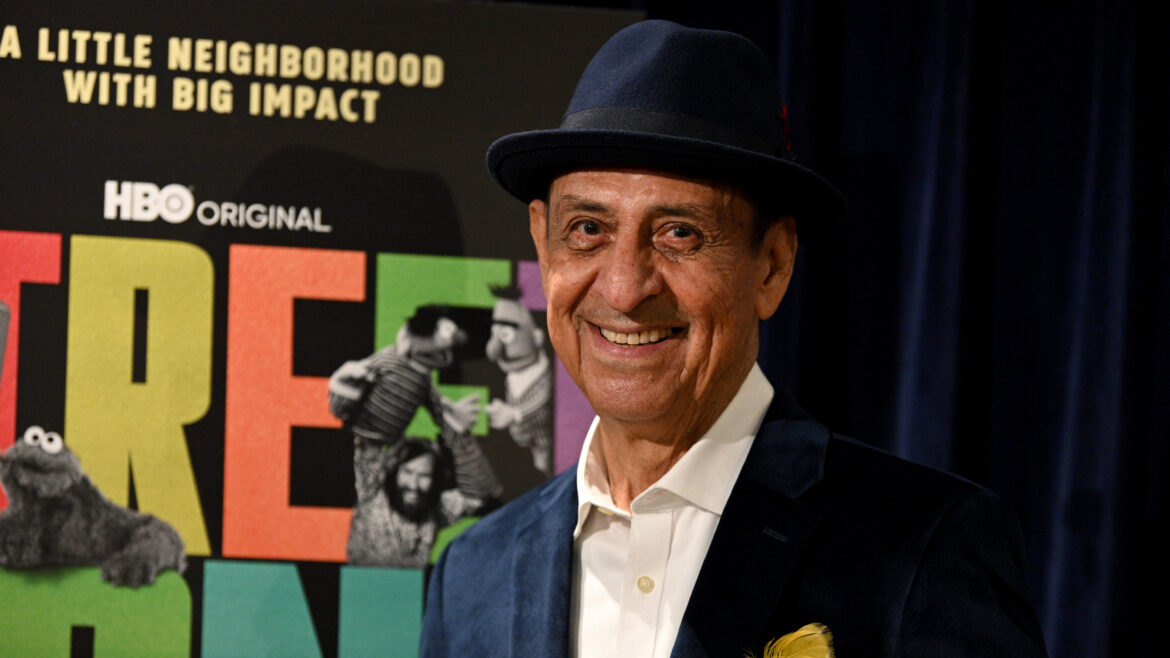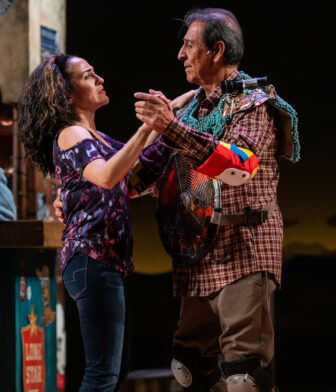Emilio Delgado, ‘Luis’ for 44 years on ‘Sesame Street,’ dies at 81

Alexi Rosenfeld / Getty Images
Emilio Delgado at a screening of "Street Gang: How We Got To Sesame Street" at Symphony Space in New York City, Dec. 10, 2021.
Emilio Delgado, the actor best known as Luis Rodriguez, the owner of the Fix-It Shop on Sesame Street, died Thursday of multiple myeloma. He was 81.
For 44 years, Luis fixed toasters, sang songs, mentored Muppets and spoke Spanish with his neighbors on Sesame Street. In doing so, Delgado made history, becoming the Mexican American actor with the longest run as the same character on U.S. television.
In addition to being a professional actor, Delgado was a talented musician and lifelong advocate for social justice and Chicano cultural representation. In public broadcasting, he found a platform through which he could reach the whole nation with this work.
Born in Calexico, Calif., and raised in Mexicali, Baja California, the border was not a barrier but a cultural milieu for Delgado as he attended school in the U.S. and shined shoes and repaired bicycles in Mexico. With extended family on both sides of the border, he soaked in the mariachi music, the trios singing boleros, and the big bands he could hear play all night in the two biergartens across the street from his house.
When he was 14, the family moved to Glendale, Calif., where he became interested in performance and spent high school in theater productions and playing trombone in the school’s symphony, marching band and jazz band. As a teenager, he became enamored with the folk music revival and began playing guitar and singing at coffeehouses around Glendale and Hollywood, mixing Irish music, African American spirituals and Kingston Trio covers with Latin folk songs like “La Bamba.” To prepare for a career in acting, he attended Glendale College and CalArts, and performed in community theater in Los Angeles.
The barriers Delgado encountered as a Mexican American adult were less permeable than the political lines of his borderlands youth: Southern California in the 1960s was a center of the Chicano movement, and Delgado became active in demonstrations against employment discrimination and racial prejudice, and in support of Hispanic farm laborers striking for fair wages. He was intimately aware of the stakes of such actions: As a supply corporal in the California National Guard called to respond to the Watts Rebellion, he saw firsthand how quickly social justice protests could be met with brutality.
When he finally broke into the acting business in 1968, he joined the SAG, AFTRA and Equity unions, and brought his advocacy of Chicano labor and culture to his profession. Frustrated that Latino actors were cast almost exclusively in menial, stereotypical roles like gang members, drug addicts and criminals, he sought to change the image of Chicanos in popular culture. Among the professional advocacy groups in which he became active was Nosotros, an organization of Mexican American actors who confronted producers and directors about the stereotypes they were perpetuating.
The work of fellow activists in the Chicano movement ultimately created the opportunity for Delgado to become Luis. Sesame Street debuted in 1969 with an integrated cast of African American and white hosts. Its mission was to engage underserved children in learning by having educational content presented by people who looked and spoke like them. Latino activists recognized an opportunity in the program’s success and petitioned the Children’s Television Workshop to include representation of Spanish language and Hispanic culture on Sesame Street. In 1971, CTW recruited new cast members to join the program’s third season, casting Puerto Rican New Yorker Sonia Manzano as Maria and recruiting the Chicano American Delgado from the West Coast to play Luis.
Delgado was never sure how CTW found him, but it may have been through two of the non-stereotypical roles he found in Los Angeles. One was as co-host of Angie’s Garage, a bilingual children’s program on a local ABC affiliate where he sang and played guitar. The other was in the Emmy Award–winning public broadcasting series Canción de la Raza, which aired on KCET-LA in 1968. This telenovela was the station’s first production specifically for Latinos, with episodes dealing with social issues in the everyday life of Mexican Americans. It also solicited viewer feedback, integrating those comments into a weekly panel show that discussed issues raised in earlier episodes.
Behind the scenes at CTW, Delgado served as the coordinator and spokesman for the Bilingual Bicultural Advisory Committee, composed of actors, writers and researchers for the program, along with advisors from different sectors of the Latino community. Several years before CTW hired any Spanish-speaking writers, this committee proposed story ideas for Sesame Street’s Hispanic characters, reviewed scripts to ensure the Spanish used would be understandable to Hispanic children familiar with various regional dialects, and brainstormed ways that the program could highlight the diversity among Latino Americans. Along with the other cast members, Delgado served as an ambassador for the program, presenting live concerts, meeting children, conducting outreach with educators across the country, and gathering feedback from community leaders about how the Sesame Street could better reach Spanish-speaking children.
On Sesame Street, Delgado was able to build a character who challenged stereotypes. Luis was a business owner, a neighbor, and later a husband and father. Delgado was able to employ his range of skills in comedy, music, and drama to bring nuance to the serious issues that the program never shied away from.
Along with the other adults on Sesame Street, Luis was more than just a teacher figure swooping in to explain how things work. He was a real person dealing with real problems, like visits to the eye doctor, a thrown-out back and bad days where you just need to spend some time alone. A 1988 story arc followed the courtship and marriage of Luis and Maria, and the birth of their daughter Gabby, ushering in two decades of representing the everyday lives of a stable Latino family — still a rarity on U.S. television. In 50 years of stand-alone episodes about daily life — from modeling cooperation to helping a child understand that learning to play an instrument takes a long time — a milestone event like Luis and Maria’s wedding was not a typical episode, and it was one that only a fraction of Sesame Street’s viewers over the years saw air. Its outsized place in Americans’ collective memory is evidence that the ideas the event represented, and the characters of Luis and Maria, became culturally important far beyond the Sesame Street broadcasts themselves.
Sesame Street’s taping schedule allowed Delgado to continue to perform other roles on stage and screen throughout his career. He played a villain on Hawaii Five-O and an ambassador in House of Cards, had a recurring role as Rubin Castillo on Lou Grant, and appeared in three of the Law & Order franchises.

In 2018, he originated the titular role in Quixote Nuevo, a new play by Octavio Solis in which he played a retired literature professor and Cervantes scholar in a southwestern border town. Facing his own mortality, Delgado’s character enlists a young neighbor in one last grand adventure to tilt at surveillance drones and find his love. The play uses literature and folk traditions to obscure the boundary between life and death and invokes the spirituality and cultural wisdom of the U.S.-Mexico borderlands to muddy the barriers between reality and imagination.
It can be tempting to assume that hosting a children’s program meant that Delgado essentially played himself. To millions of Americans, Emilio Delgado is Luis Rodriguez. But this elision between Emilio the actor and Luis the character truly reveals the depth of Delgado’s acting skill. Without compromising his commitments to music, activism and Chicano culture, he managed to create a character that became real to generations of audiences. And through the platform of public broadcasting, he was able to make the Spanish language and Mexican American culture an indelible part of life for countless children across the country.
Kathryn Ostrofsky, Ph.D., is an historian of media and sound who studies Sesame Street in American culture. She is the Digital Archive Coordinator for www.bunkhistory.org, a database of short-form popular history curated by New American History at the University of Richmond.






